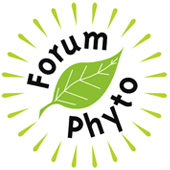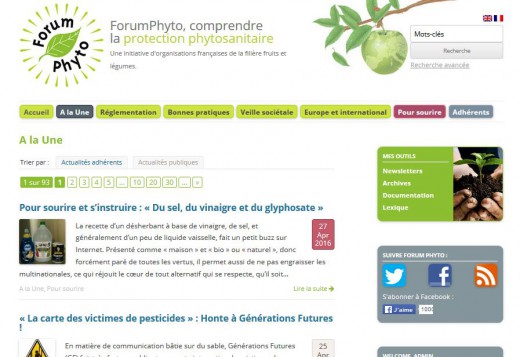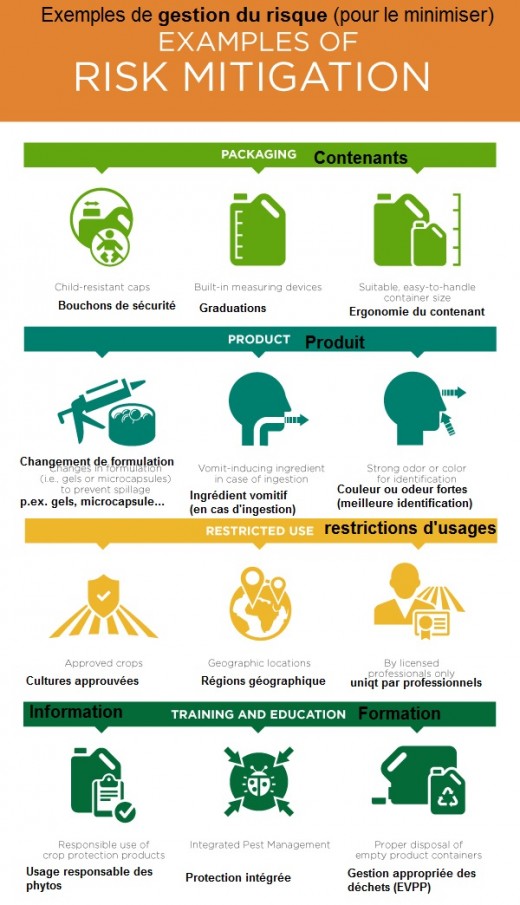
The 20th of June 2017 Freshfel AGM celebrated the 30 year work anniversary of Philippe Binard, General Delegate. He…

Our site appearance is changing, with 3 main objectives:
– A clearer and more readable display
– A more simple display for mobile terminals (smartphones and tablets)
– In consequence, a better indexing on search engines
Notinhing else has changed : every former address is still functional.
Your remarks are welcome.

A “homemade” herbicide recipe is floating around the web : salt, vinegar and dish soap. Many of you have probably seen it posted to Facebook or Twitter or Pinterest, or on your favorite home gardening site. Is it efficient, safe and cheap? That is the question Control Freaks, a Weed Science blog which is linked to USDA, answers to in “Salt, Vinegar, and Glyphosate”
A funny and well-documented story which is worth reading.
Effectiveness
Homemade herbicide is efficient on annual weeds. But for perennials, glyphosate is paramount.
Cost
Glyphosate is clearly “less expensive than the homemade mixture on a per-gallon, ready-to-spray basis”.
Toxicity
Both homemade and glyphosate are really not so toxic per se.
Nevertheless, acetic acid is more toxic than glyphosate.
But the main thing is you need to apply 6-times higher rates for homemade herbicide.
Globally, the homemade herbicide is “nearly 10 times more lethal to mammals than glyphosate, one of the most potent weed killers on the planet”
The author concludes: ”
Maybe you’re not worried about the safety aspect; you simply don’t want to purchase Roundup because you dislike Monsanto. Well, don’t forget that vinegar is often made from corn, and most corn in the US has the Roundup Ready trait (which was developed by Monsanto). So the vinegar you are using to spray your weeds is probably made from corn that was sprayed with glyphosate: the very herbicide you were trying to avoid.
All joking aside, the important thing to keep in mind is that both the homemade vinegar + salt mixture and Roundup are pretty darn safe when used properly, they’re both relatively inexpensive, and both can provide effective weed control in the appropriate situation. Now, all this discussion has made me hungry for some Roundup Ready sweet corn, with just a little salt, and a salad with a nice vinaigrette dressing.”
Bon appétit!
In Canada, General Mills, owner of the Honey Nut Cheerios trademark, has decided to put away their bee-mascot from packaging for some weeks. This way, they aim to make their customers be aware of the massive bee death. They offer free wildflowers seeds to every Canadian to bring back the bees.
Have a look to #bringbackthebees (in English) or ramenonslesabeilles (en français)
This initiative relies on a 2013 TED talk video by Maria Spivak, a bee specialist at Minnesota University (USA). Recent data show a better bee health than told in the talk. In addition, Maria Spivak feed a disputable argument against neonicotinoids. But she stresses the essential role of a diversified and abundant food to make bees happy and healthy..
For sure, it’s also an easy way for promoting the trademark Cheerios. A kind of « greenwashing » in a way.
But this effort to make young people active in a positive way for bee health and well-being may be appreciated.
One could encourage European retail companies to act the same way, instead of inflicting new non-regulatory, non-realistic and counterproductive requirements everyday to growers.
In November 2015, EFSA finalised the re-assessment of glyphosate, well-known active substance of Monsanto’s Roundup and other herbicides.
Read EFSA press release, and detailed explanations on its risk assessment. The report concludes that glyphosate is unlikely to pose a carcinogenic hazard to humans and proposes a new safety measure that will tighten the control of glyphosate residues in food.
Environmentalist NGOs are really angry. Pr Portier, and 96 “independent” scientists diosagreed too and wrote an open letter to EU Health Commissioner, Vytenis Andriukaitis.
Again, EFSA explains and answers these attacks.
Read the Pr Portier open letter
On December 2015 the 15th, Commissioner Vytenis Andriukaitis answered Pr Portier, reminding the way expertise and decision making operate in EU, and how EU is transparent and tight.He invited him to answer positively to the invitation to debate from EFSA.
On January 2016 the 13th, EFSA publishes an detailed answer including:
– The answer of Bernhard Url, EFSA executive director . This answer is transparent, open and steady at once: EFSA considers the former IARC statement as “a possible first step in a full assessment”. But EFSA has also taken in account all the other valid studies and data. It invites IARC (OMS) to discuss scientific divergences. This letter includes specific responses to Pr Portier and others.
– An infographic on “Who assesses pesticides in the EU?” In the glyphosate case, at the end, all Member States, except Sweeden, agreed the EFSA assessment that Glyphosate should not be classified as carcinogenic.
– An interactive infographic specifying the regulation process for pesticides approbation (or not) in EU.
On December 2015 the 1st, Bernhard Url, in a hearing by the Eruopean Parliament, had declared in a more informal way: “People that have not contributed to the work, that have not seen the evidence, most likely, that have not had the time to go into the detail, that are not in the process, have signed a letter of support. Sorry to say that, for me, with this, you leave the domain of science, you enter into the domain of lobbying and campaigning, and this is not the way EFSA goes. For me this is the first sign of the Facebook age of science. You have a scientific assessment, you put it in Facebook and you count how many people like it. For us, this is no way forward. We produce a scientific opinion, we stand for it but we cannot take into account whether it will be liked or not”.
In “EFSA accuses world-class cancer experts of engaging in ‘Facebook science'”, Franziska Achterberg, Greenpeace, totally disagrees….
But in fact, what B Url doesn’t accuse the “world class cancer experts” for their statement, but judges the process of pressure on EFSA with an open letter. And, for sure, EFSA has to remain independent of these pressures, which, by definition, are not scientific. Whether environmentalist NGOs agree or not.
– Clearly make the difference between risk and hazard (Andrew Maynard, Michigan University, USA)
– “They killed the cats! Precaution, superstition and eco-zealots” (The Risk-Monger)
– “Why You Should Thank A Caterpillar For Your Mustard And Wasabi” (NPR, USA)
– How to Make a Natural Weed Killer (Andrew R. Kniss)
 CropLife International put on the Internet some pages based on the work of Andrew Maynard, who directs the Risk Science Center at the University of Michigan’s School of Public Health (USA). Read « Meet the Risk and Hazard Guru » Watch 5 videos of graphical explanations, including the funny “Risk Song”. At last,more concrete for ForumPhyto readers, CropLife also…
CropLife International put on the Internet some pages based on the work of Andrew Maynard, who directs the Risk Science Center at the University of Michigan’s School of Public Health (USA). Read « Meet the Risk and Hazard Guru » Watch 5 videos of graphical explanations, including the funny “Risk Song”. At last,more concrete for ForumPhyto readers, CropLife also…
 That is the title of an article (in English) by David Zaruk, on his blog The Risk-Monger D Zaruk starts with an historic fact “During the Great Plague of London (1665-66), the authorities were convinced that the outbreak of bubonic plague was being spread by cats. As cats had then been looked upon by religious leaders as symbols of evil and…
That is the title of an article (in English) by David Zaruk, on his blog The Risk-Monger D Zaruk starts with an historic fact “During the Great Plague of London (1665-66), the authorities were convinced that the outbreak of bubonic plague was being spread by cats. As cats had then been looked upon by religious leaders as symbols of evil and…

« The next time you dab wasabi on your sushi or spread mustard on your hot dog, take a moment to thank a caterpillar » : That’s how begins this article (in English) by NPR, a public radio in the USA It’s based on a scientific article published in Proceedings of the National Academy of Sciences, where “a group of scientists…
 In this article, Andrew R. Kniss, University of Wyoming (USA), Associate Professor, Weed Biology & Ecology, “introduces when bilanaphos enters the plant, about half of the molecule is quickly chopped off, leaving behind a smaller molecule – phosphinothricin”, which is an herbicide. So…
In this article, Andrew R. Kniss, University of Wyoming (USA), Associate Professor, Weed Biology & Ecology, “introduces when bilanaphos enters the plant, about half of the molecule is quickly chopped off, leaving behind a smaller molecule – phosphinothricin”, which is an herbicide. So…
In this article, Andrew R. Kniss, University of Wyoming (USA), Associate Professor, Weed Biology & Ecology, “introduces [us] to a fascinating chemical named bilanaphos”.
Bilanophos is substance produced naturally by two naturally occurring bacteria. […] when bilanaphos enters the plant, about half of the molecule is quickly chopped off, leaving behind a smaller molecule – phosphinothricin”, which is an herbicide.
So “that sounds very much like a natural herbicide, right? Not so fast… Phospinothricin (better known in the US as glufosinate) is widely used as a herbicide today” and “is produced synthetically. So it is not considered a ‘natural’ herbicide.”
“The story of phosphinothricin, while very interesting, is not unique. […] Between 1997 and 2010, USDA scientists estimate that about 69% of all new pesticide active ingredients registered by the EPA were either natural products, synthetic products derived from natural sources (like phospinothricin), or biological in nature.”
In fact, the word natural “is an often-used marketing term with no clear definition. […] The ‘natural or not‘ distinction can distract from what is really important when discussing pesticides. […] The properties of the compound are far more important, in my opinion, than the source of the compound. […] But there are questions related to the source of the product that can be important. In particular, which has a greater impact, synthesis in the lab? or extraction from natural sources? […] If extracting something from nature means we’ll have a greater negative impact on the environment than we would producing it in a factory, then please give me the synthetic version.
This article is a model pedagogy on « natural » vs « synthetic ». It has to be read…
Two cards picked up on the Internet:
– One video which is a sign for an agriculture looking to the future:
1 tracteur + 1 drone + 1 ha de neige.
– A Christmas « meme » from David Zaruk, specialist in science and risk communication:
CropLife International[1] put on the Internet some pages based on the work of Andrew Maynard, who directs the Risk Science Center at the University of Michigan’s School of Public Health (USA).
Read « Meet the Risk and Hazard Guru »
Watch 5 videos of graphical explanations, including the funny “Risk Song”.
At last,more concrete for ForumPhyto readers, CropLife also publishes a poster which shows concrete actions for mitigating the risk in the cas of Plant Protection Products. Look at Risk Mitigation. It describes actions which are put in place by regulators and PPP manufacturers.
It would be useful to add actions which are implemented by the growers themselves: agronomic and preventive actions, use of complementary (or “alternate”) means, sprayers adjusting and maintenance, appropriate filling facilities,..
In short: Yes, Pesticides are dangerous
But:
1) Even if they are not asilver bullet, they are useful for Crop Protection.
2) The real risks can be dramatically reduced by appropriate actions
To go further : “Clairement distinguer danger et risque. « Risque = Danger x Exposition »” (in French), including this article from David Zaruk (in English).

[1] International Association of plant product manufacturers
Tous les articles récents édités par ForumPhyto.
Suivre l'évolution de la règlementation de la protection phytosanitaire.
Connaître les bonnes pratiques phytosanitaires et comprendre les enjeux.
Décrypter les actions médiatiques sur les questions phytosanitaires.
Comprendre les enjeux économiques et mondiaux de la protection phytosanitaire.
Tous les articles édités par ForumPhyto et classés par date.